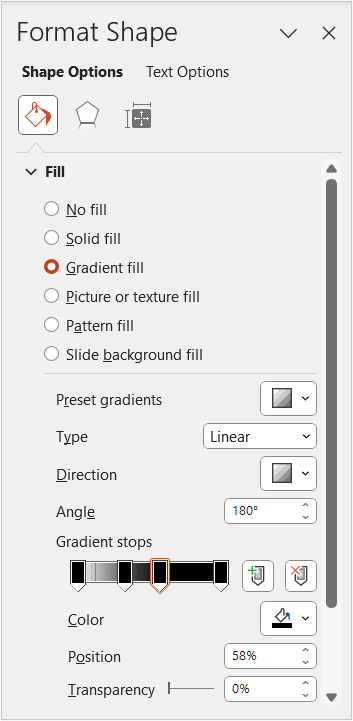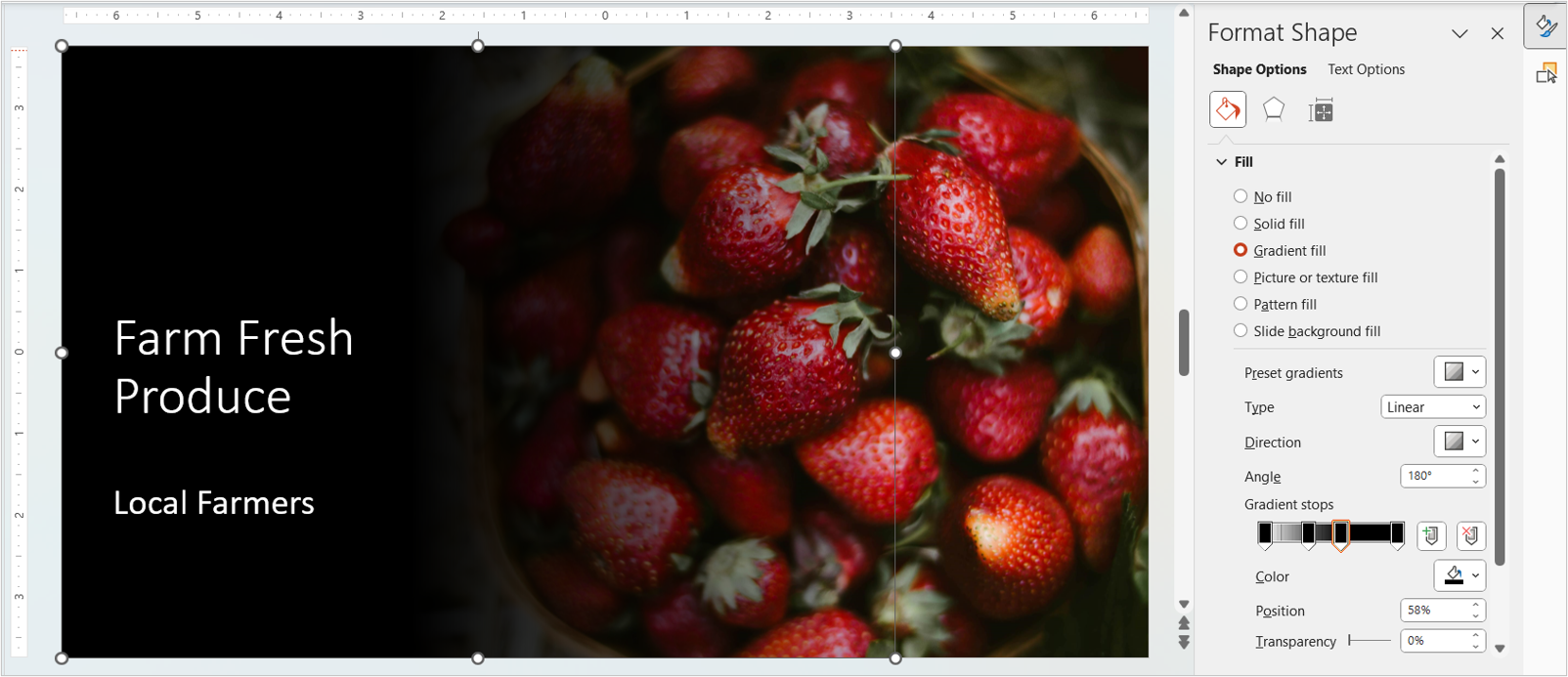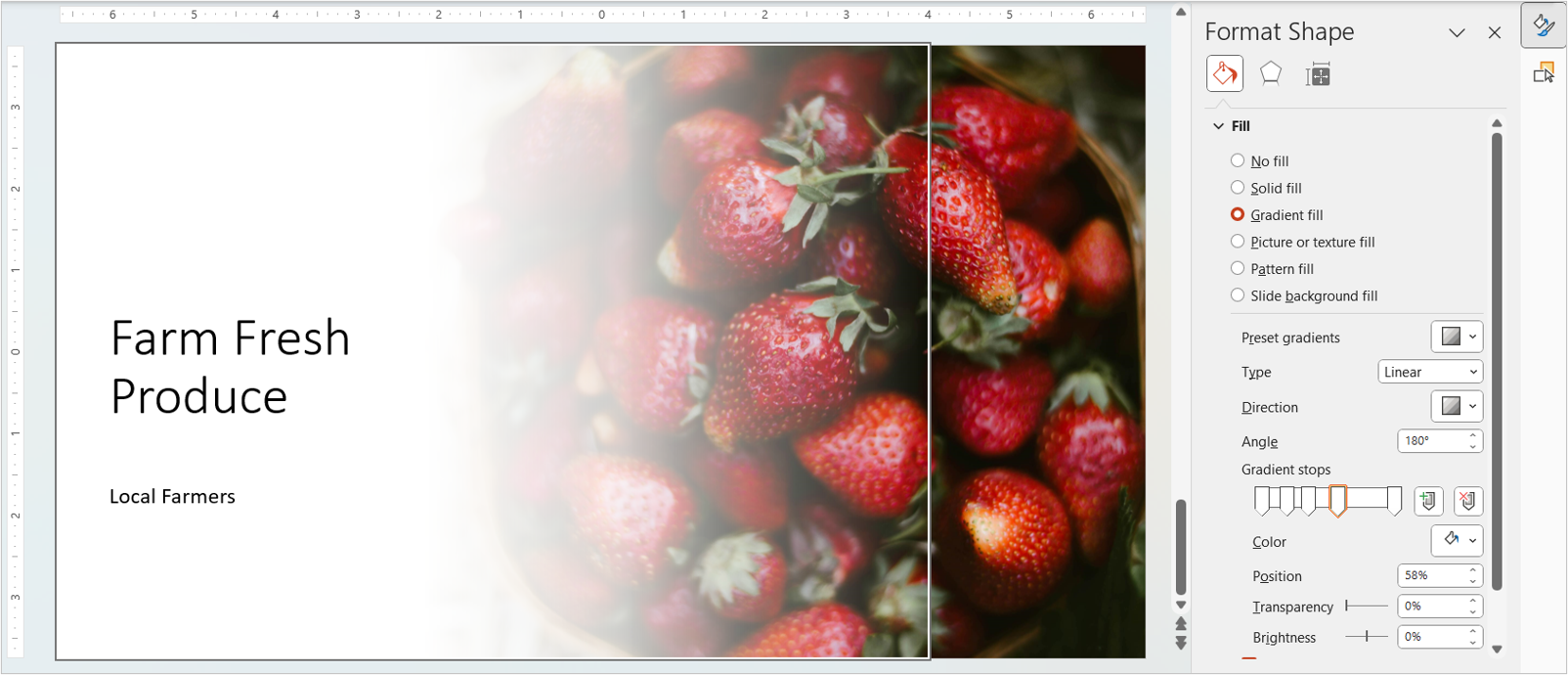Fade an Image into the Background in PowerPoint
by Avantix Learning Team | Updated September 15, 2023
Applies to: Microsoft® PowerPoint® 2013, 2016, 2019, 2021 and 365 (Windows)
You can fade a picture in PowerPoint by drawing a rectangle shape on top of the picture and then filling the rectangle with a gradient from opaque to transparent. This technique is often used to fade an image into the background of a slide. Since the rectangle is placed on top of the image and then text may be placed on top of the rectangle, you may need to reorder the objects.
An easy way to change the stacking order of objects is to right-click an object and select Bring to Front or Send to Back from the drop-down menu.
Recommended article: How to Change Slide Background in PowerPoint
Do you want to learn more about PowerPoint? Check out our virtual classroom or in-person classroom PowerPoint courses >
A fade effect using a gradient fill or overlay is different from adding an animation to fade a picture in and out during a slide show.
In this article, we'll look at:
- How to fade a picture using a gradient
- Picture fade example with a black background
- Picture fade example with a white background
- Tips for using fade effects
In the following example, a picture has been placed on a slide with text. The user would like to fade the picture into the background. The background may be white or black or some other color. In the following examples, we'll simply use a white and a black background.
The slide below includes a picture and two text objects and the user would like to fade the image on the left:
Fade a picture using a gradient
To fade a picture, or part of a picture, using a gradient on a slide:
- In Normal View, insert a picture on a slide. You can use the Insert Picture command on the Insert tab in the Ribbon or copy and paste the picture onto the slide.
- Click the Insert tab in the Ribbon and select Shapes. A drop-down menu appears.
- Select a rectangle and then drag the cursor over the picture to draw a rectangle.
- Drag the handles of the rectangle to resize it.
- Right-click the rectangle and select Format Shape. A task pane appears.
- Click Fill & Line at the top of the task pane.
- Click the arrow beside Line to expand it.
- Click No line.
- Click the arrow beside Fill to expand it.
- Click Gradient Fill.
- Choose Linear in the Type drop-down menu.
- Select a Direction and Angle from the drop-down menus.
- To add a gradient, click Add gradient stop beside the Gradient bar. To remove a gradient, click the stop and click Remove gradient stop beside the Gradient bar. You can drag the bars left or right to change their location or enter the Position percentage for a precise position.
- Click a stop and select a color from the Color drop-down menu.
- Change the stop position by entering a value for Position and change the transparency settings by dragging the slider.
- Repeat for other stops.
The Format Shape task pane appears as follows with gradient stops:
Picture fade example with a black background
In the following example, a rectangle has been drawn ¾ of the size of the slide on top of the picture and a gradient has been applied to the shape:
For the selected rectangle, the Type is Linear, the Direction is Linear Left and the Angle is 180. The background of the slide is black.
The gradient stops have been set as follows:
Stop 1:
Color: Black
Position: 0%
Transparency: 100%
Stop 2:
Color: Black
Position: 33%
Transparency: 36%
Stop 3:
Color: Black
Position: 58%
Transparency: 0%
Stop 4:
Color: Black
Position: 100%
Transparency: 0%
The final slide appears as follows:
Picture fade example with a white background
In the following example, a rectangle has been drawn ¾ of the size of the slide on top of the picture and a gradient has been applied to the shape:
For the selected rectangle, the Type is Linear, the Direction is Linear Left and the Angle is 180. The background of the slide is white.
The gradient stops have been set as follows:
Stop 1:
Color: White
Position: 0%
Transparency: 100%
Stop 2:
Color: White
Position: 19%
Transparency: 62%
Stop 3:
Color: White
Position: 35%
Transparency: 21%
Stop 4:
Color: White
Position: 58%
Transparency: 0%
Stop 5:
Color: White
Position: 100%
Transparency: 0%
The final slide appears as follows:
You can experiment with colors, position and transparency settings to get the result you want.
Tips for using fade effects
When applying a gradient fade effect to a picture in PowerPoint, consider the following:
- You will get very different results based on stop position, transparency and color settings.
- If you want the picture to blend into the background, the stop points must use the exact background color.
- If you have a version that supports PowerPoint Designer, the Designer can create similar designs but they can be difficult to replicate (and select objects).
- PowerPoint Designer does not create layouts so if you want a layout with a gradient, you'll need to create it yourself.
- If you create the gradient shapes yourself, you can keep an asset file with gradient shapes to copy and paste into other presentations.
Subscribe to get more articles like this one
Did you find this article helpful? If you would like to receive new articles, JOIN our email list.
More resources
How to Rotate Objects in PowerPoint
10 Great PowerPoint Drawing Tricks and Shortcuts
How to Use the Eyedropper in PowerPoint to Match Colors
How to Lock an Image, Shape or Other Object in PowerPoint
How to Add Animation in PowerPoint (Animate Pictures, Shapes, Text and Other Objects)
Related courses
Courses are available in-person or online in virtual classroom format.
Microsoft PowerPoint: Intermediate / Advanced*
Microsoft PowerPoint: Design for Non-Designers
Microsoft PowerPoint: Animations Bootcamp
Microsoft Excel: Intermediate / Advanced*
Microsoft Word: Intermediate / Advanced*
*Core competency courses
Our instructor-led courses are delivered in virtual classroom format or at our downtown Toronto location at 18 King Street East, Suite 1400, Toronto, Ontario, Canada (some in-person classroom courses may also be delivered at an alternate downtown Toronto location). Contact us at info@avantixlearning.ca if you'd like to arrange custom instructor-led virtual classroom or onsite training on a date that's convenient for you.
Copyright 2024 Avantix® Learning
You may also like
How to Insert or Type E with an Accent Mark in PowerPoint (È, É, Ê, Ë, è, é, ê, or ë)
You can insert or type e with an accent mark in PowerPoint using built-in tools or keyboard shortcuts (including Alt code shortcuts). The letter e can be inserted with an accent in both upper or lower case in text boxes or placeholders on slides, the slide master or layouts. The following are common accents in upper or lower case – È, É, Ê, Ë, è, é, ê, or ë.
How to Lock an Image, Shape or Other Object in PowerPoint
You can now lock an image, shape or other object in PowerPoint. Objects can be locked in Normal View or Slide Master View. Only PowerPoint 365 users can lock objects to prevent moving and resizing. This is helpful if you want to select and move other objects on the slide or prevent others from moving or resizing an object. You can lock items using the context menu or the Selection Pane.
PowerPoint vs Google Slides (Full Feature Comparison + Benefits)
When comparing PowerPoint vs Google Slides (and trying to decide which is the better choice for your needs), you will need to consider versions when you compare the two applications. In this article, we'll compare the desktop or downloadable version of PowerPoint vs Google Slides, an online program that works in a browser. The key difference then if you are comparing PowerPoint vs Google Slides is that PowerPoint must be downloaded and runs on your desktop and Google Slides runs online. The desktop version of PowerPoint is a robust, full-featured program with many advanced features. You can buy PowerPoint as a stand-alone version or as part of a Microsoft 365 subscription. If you are a 365 subscriber, new features roll out on a regular basis.
Microsoft, the Microsoft logo, Microsoft Office and related Microsoft applications and logos are registered trademarks of Microsoft Corporation in Canada, US and other countries. All other trademarks are the property of the registered owners.
Avantix Learning |18 King Street East, Suite 1400, Toronto, Ontario, Canada M5C 1C4 | Contact us at info@avantixlearning.ca














